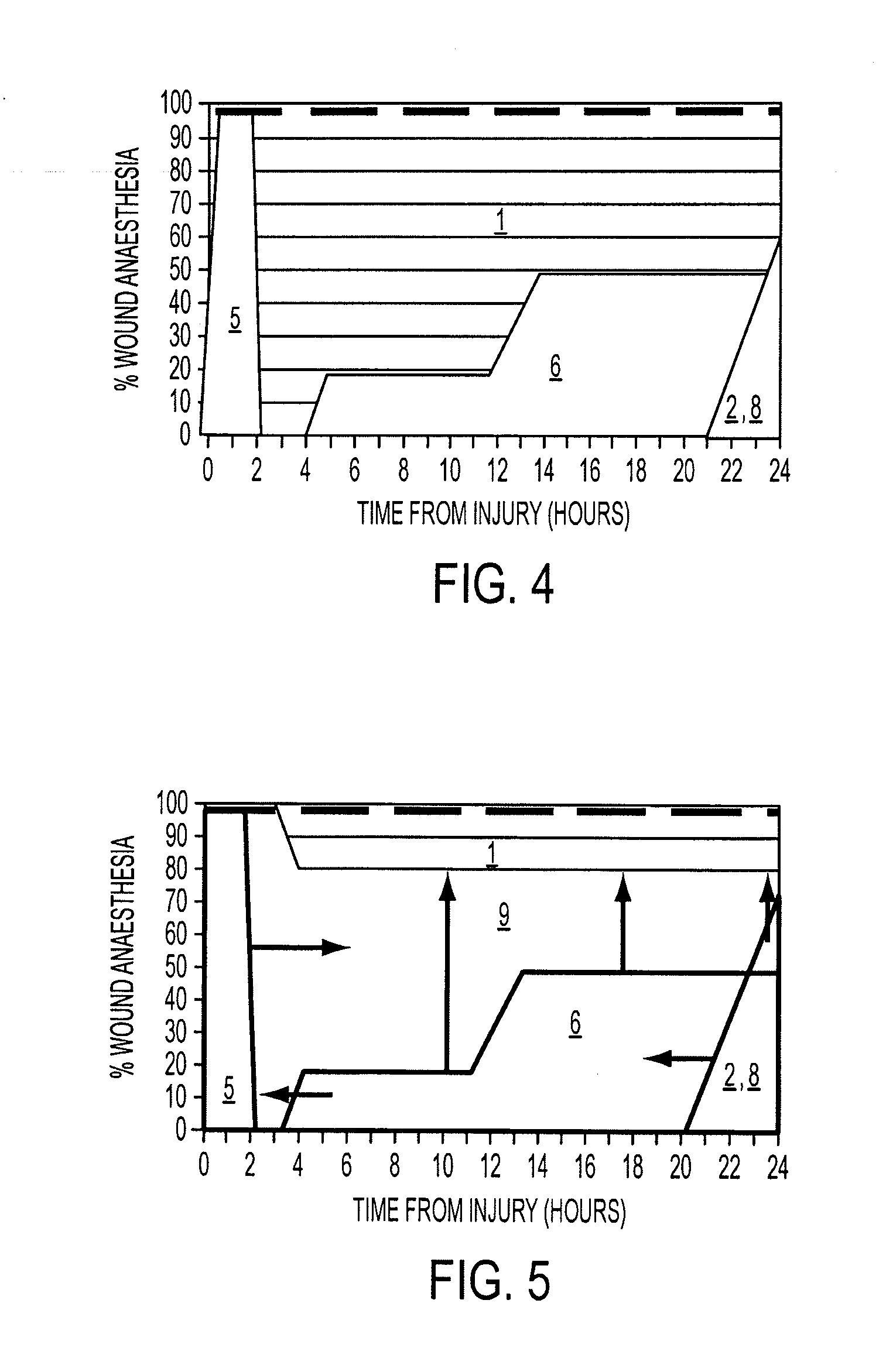Topical analgesic composition
a topical analgesic and composition technology, applied in the field of topical analgesic composition, can solve the problems of local tissue swelling and edema, reduce the efficacy and potency of this method of application, and lower the pain threshold of surrounding tissues, so as to prolong the contact of the anesthetic agent. the effect of promoting and prolonging the conta
- Summary
- Abstract
- Description
- Claims
- Application Information
AI Technical Summary
Benefits of technology
Problems solved by technology
Method used
Image
Examples
example 1
Formulation of a Topical Analgesic Gel for Open Wounds Having a Long Duration of Action
[0128]This example describes the preparation of a particularly preferred topical analgesic composition for the management of significant open wounds. The composition is in the form of a spray-on gel that provides a prolonged analgesic effect. The composition has the following formulation:
Purified water Sorbitol Liquid 70%100.0 mg / mLNon-CrystallizingLignocaine HCl50.0 mg / mL (5%)Bupivacaine HCl5.0 mg / mL (0.5%)Sodium Metabisulfite1.5 mg / mLCetrimide0 mg / mL-5.0 mg / mLAdrenaline Tartrate45.0 μg / mLFood Dye (e.g. brilliant blue)Quantity to suit (q.s.)Hydroxy Cellulose5.0 mg / mLPurified waterto 1 mL
[0129]The composition is prepared by combining the above ingredients to achieve the required color and consistency as required. The composition is then placed within a suitable spray-on applicator. The composition is viscous and, when applied, is in the form of a “sticky” gel.
[0130]Sorbitol functions as a thickene...
example 2
Formulation of a Topical Analgesic Gel for Open Wounds
[0134]This example describes the preparation of another preferred topical analgesic composition for the management of significant open wounds. The composition is in most respects the same as the composition of Example 1, except that it excludes bupivacaine. The composition has the following formulation:
Purified water Sorbitol Liquid 70%100.0 mg / mLNon-CrystallizingLignocaine HCl40.0 mg / mL (4%)Sodium Metabisulfite1.5 mg / mLCetrimide0 mg / mL-5.0 mg / mLAdrenaline Tartrate36.0 μg / mL (1:2000)Food Dye (e.g. blue)q.s.Hydroxy Celluloseq.s.Purified waterto 1 mL
[0135]The composition is prepared by combining the above ingredients to achieve the required color and consistency as required. The composition is then placed within a suitable spray-on applicator. The composition is viscous and, when applied, is in the form of a “sticky” gel. Typically, the composition will comprise about 5 mg / mL hydroxy cellulose in combination with about 100 mg / mL no...
example 3
Use of the Composition of Example 1 in Mulesing
[0137]This example describes the use of the composition of Example 1 in a mulesing trial.
[0138]If necessary, the breech area of the sheep is crutched of wool. Mulesing is then performed. This involves removing strips of skin from either side of the perineum and from the dorsal surface of the tail. The tail may be docked at the same time. The composition is then immediately applied to the surgical wound as a colored gel by a metered dose spray-on pump pack or trigger spray bottle. The agent is applied in an adequate volume to effectively cover the open wound surface. Between 5-15 mLs of the composition is applied depending on lamb weight and wound size.
[0139]The results of the trial are discussed hereafter.
[0140]Significant (p<0.05) induction of wound anesthesia (as demonstrated by absence or reduction of the incidence of allodynia and wound hyperalgesia and reduced pain related behavior responses) occurred in an 8 hour monitored period ...
PUM
| Property | Measurement | Unit |
|---|---|---|
| distance | aaaaa | aaaaa |
| weight/volume | aaaaa | aaaaa |
| viscous | aaaaa | aaaaa |
Abstract
Description
Claims
Application Information
 Login to View More
Login to View More - R&D
- Intellectual Property
- Life Sciences
- Materials
- Tech Scout
- Unparalleled Data Quality
- Higher Quality Content
- 60% Fewer Hallucinations
Browse by: Latest US Patents, China's latest patents, Technical Efficacy Thesaurus, Application Domain, Technology Topic, Popular Technical Reports.
© 2025 PatSnap. All rights reserved.Legal|Privacy policy|Modern Slavery Act Transparency Statement|Sitemap|About US| Contact US: help@patsnap.com



